Former DreamWorks animator Jason Porath has a list of princesses you won’t see in the Disney lineup any time soon. His new site RejectedPrincesses.com highlights these characters with a rundown of their unnerving back story.
Wu Zetian
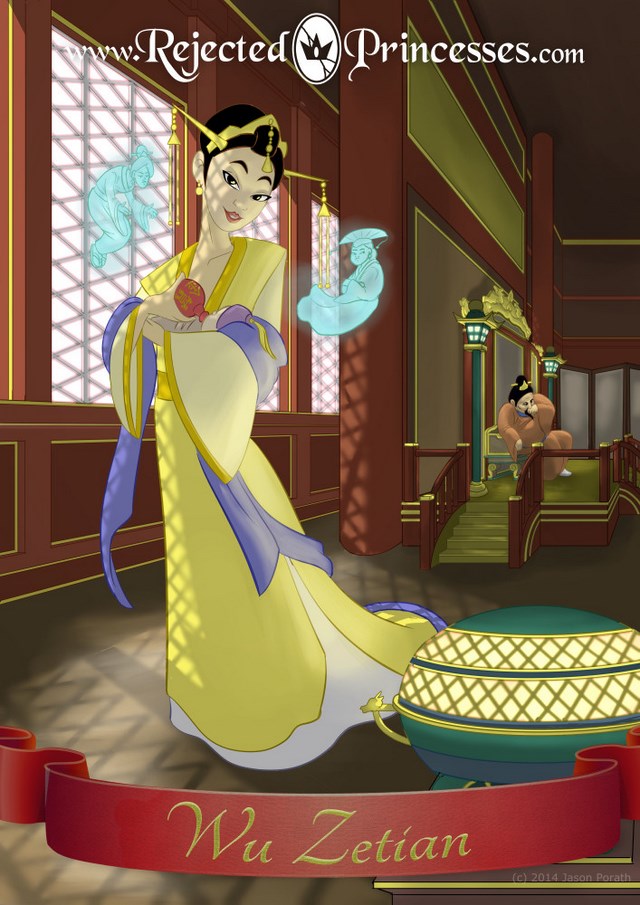
Introducing Wu Zetian, first and only Empress of China — seen here poisoning her infant daughter. Now, that’s actually a bit of a historical inaccuracy: the generally-accepted truth was that she *strangled* her young daughter, to frame the old queen and get her out of the way. It worked — both the old queen and the old queen’s mother were executed, and haunted her from that point forward. I thought they’d make good comic relief characters in the movie adaptation. From there, she ascended to be Emperor Gaozong’s predominant consort, and set about eradicating all other claimants to the throne.
Early on, her method of choice was a slow-acting poison made from silkworms. As time went on and her influence grew, however, she took to engineering treason charges for her opponents, summoning them to the throne room and making them kill themselves in front of her. That’s some cold shit. Once the emperor died, her oldest son ascended to the throne, and proceeded to ignore her. She didn’t take kindly to this, and had him drubbed out of office, and later forced to commit suicide. In his place, she installed her youngest son, whom she basically locked in his room, so she could rule in his stead. Before long, she dropped all pretense of being the queen regent, and formally declared herself the official empress of China. Her reign saw the complete rearrangement of dynastic succession, as she systematically wiped out any and all claimants to the throne. In one year alone, she destroyed fifteen family lines, mostly through executions and enforced suicides. How did she drum up her accusations of treason, you ask? By putting, essentially, anonymous comment boxes sprinkled throughout the palace. When someone pissed her off, she’d have her servant write a tattle-tail letter and place it in a comment box. Within days, they’d be but to the sword — usually their own. This is almost undoubtedly the most hardcore use of an anonymous comment box in history. She also had an enormous network of spies and a secret police, who further kept any rivals at bay. If you really got on her bad side, she would enact the “human pig” torture — wherein your arms and legs were cut off, your tongue was removed, and you were force-fed and left to wallow in your own excrement. Empress Wu did not mess around. For people outside of political circles, her reign was peaceful and prosperous. She left the general population be, and opened up the civil examinations to a wider range of people, making for more diversity in the local and regional governments. As long as you didn’t cross her, she was pretty cool. She never remarried, although she did end up banging a Buddhist monk for a lot of her life, and took two younger fellas as lovers late in life. Hardcore lady. Art note: * The throne room is based off of ones in the Forbidden City, although it’s a bit of a melange of several different rooms. * Her outfit, as well as that of Emperor Gaozong, are simplified, but fairly accurate. * The two queen ghosts hovering around her head are also based off of historical representations. * The baby bottle she has in her hand is also based off of the oldest Chinese baby bottle reference I could find. * The characters on the baby bottle spell “gold silkworm,” a reference to the type of poison she likely used — a slow-acting poison made from the bodies of silkworms.
Nzinga Mbande
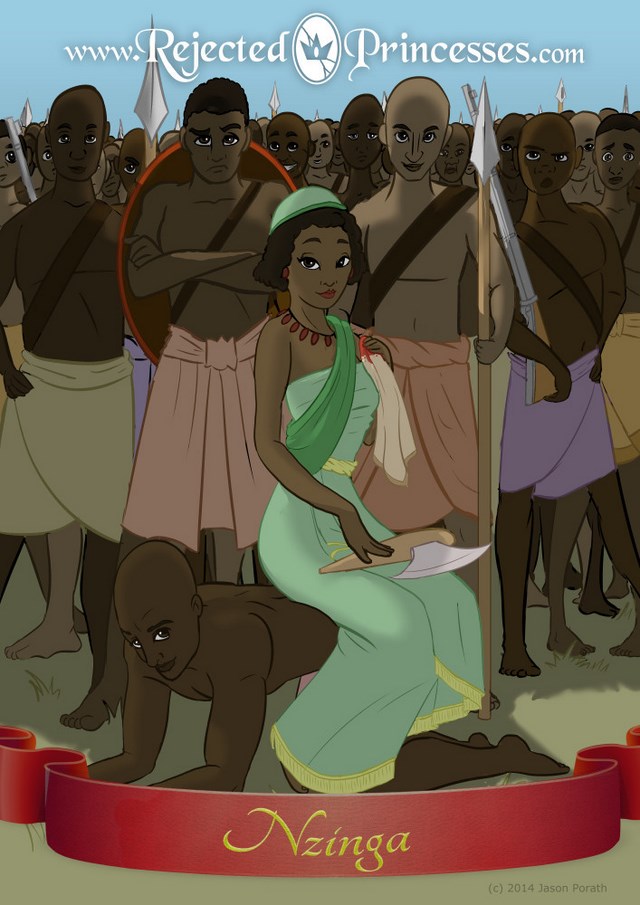
Here’s another one of my favorite Rejected Princesses — Nzinga Mbande, 17th-century African queen of what is now Angola. She began her political life as her nation of Ndongo was fighting off a Portuguese invasion. Her brother, a by-all-accounts wimp, could not bend over backwards far enough for the Portuguese, and once he ascended to the throne, the Portuguese just tossed him in jail and took over. Nzinga approached the Portuguese and demanded her brother’s return and that they leave Ndongo. At their meeting, in a sign of disrespect, the Portuguese offered her no chair to sit in, instead providing merely a floor mat fit for servants. In response, Nzinga ordered one of her servants to get on all fours, sitting on her as she would a chair. After the negotiations concluded, she slit her throat in full view of everyone, and informed them that the Queen of Ndongo does not use the same chair twice. Shortly thereafter, the Portuguese agreed to let her brother go. With her brother now safely back home, she proceeded to murder him in his sleep, kill her brother’s son, and assume the throne herself – because if you’re going to do something right, you better do it yourself. From there, she moved south, conquered the infamous ruthless cannibal tribe known as the Jaga, made them her slaves, and waged war on the Portuguese for THIRTY FIVE YEARS. Rumors of her badassness grew increasingly outlandish throughout her life. By some accounts, after killing her brother’s family, she ate their hearts to absorb their courage. As a pre-battle ritual, she was rumored to have decapitated slaves and drank their blood. It is widely-accepted that she maintained a 60-man-strong harem throughout her life — men who, by many accounts, would fight each other to the death for the right to share her bed for the night. She also apparently dressed some of them like women. Conversely, she staffed her army with a large number of women warriors. After decades of killing the Portuguese, they eventually threw their hands up and negotiated a peace treaty. She died several years afterwards, at the ripe old age of eighty. There are statues of her all over Angola to this day. In fact, her outfit and axe are derived directly from one of those statues.
Pasiphae
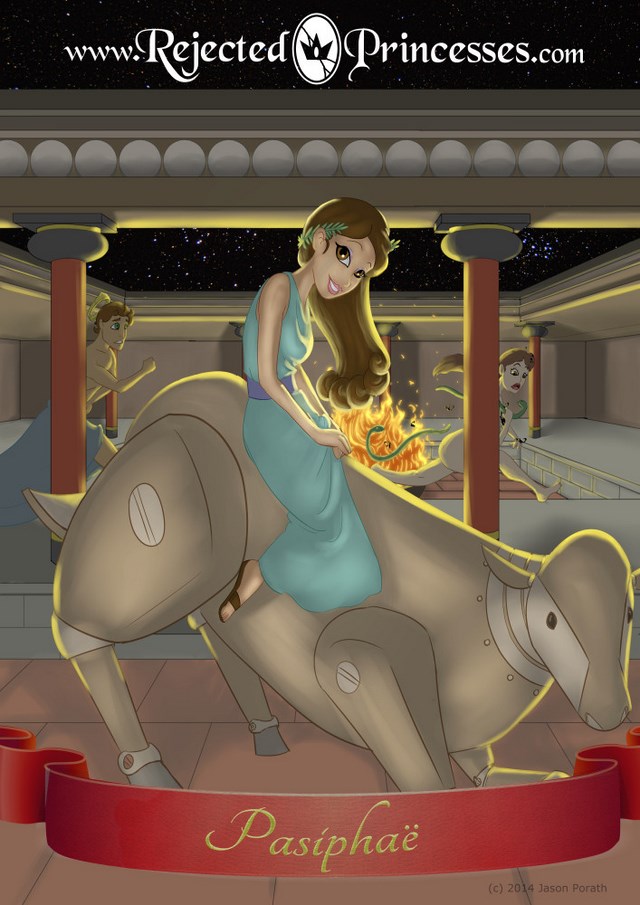
Next Rejected Princess for you all: Pasiphaë, mythological Greek queen. Pasiphaë is best known for two things. The first, and better known of the two, was that she had an insatiable need to have sex with a bull. Not just any bull, but a bull that Poseidon gave her husband, king Minos. So the legend goes, her husband was supposed to sacrifice the bull back to Poseidon, but decided to keep it. In response, Poseidon was like, “Hey Pasiphaë, you know what’d be real good right now? Bull penis.” So she had the court inventor, Daedalus, build her a hollowed-out wooden cow so that she could have sex with the bull. She later gave birth to the Minotaur. Daedalus got busy building a labyrinth. The second thing she was well-known for was ruining her husband’s sex life. Being a powerful sorceress (her sister was Circe) and knowing that her husband was cheating on her, she made a charm such that if he slept with anyone save her, he would ejaculate serpents, scorpions, and millipedes. Gross. Now, here’s where it gets weird. Her husband’s mother, Europa (after whom Europe itself is named), had almost the exact same story. In her story, Zeus took the form of a beautiful bull, approached her, carried her out to an island in the ocean, and mated with her. She then had three kids, one of whom was king Minos – Pasiphaë’s husband. Notably Europa’s tale didn’t have the whole arachnid-semen part of the story. So what’s the deal? As best as historians are able to determine, they were the same legend. Europa was the Minoan version, and Pasiphaë the Greek one. When the Greeks rolled through and conquered Minoa, they essentially rewrote things. Instead of her being a powerful and in-charge woman, she was a depraved and lustful pawn. Their way of breaking Minoan traditions and bending it to their own ends. Dick move, guys. Artistic notes: * Her laurel garland makes two horns (she was often depicted with a horned crown, being a bull goddess). * The night sky in the background is the Taurus constellation, naturally. * The setting is a direct copy of king Minos’s palace at Knossos (which really exists). * The cow is modeled after a native breed local to that region called the Greek shorthair. * The only severe inaccuracy I’m aware of is that the cow was supposed to be on wheels – probably a reference to an actual statue that the ancient Minoans used. I liked it better with hooves though. Oh, and the lady in the background is wiping scorpions off her chest and there are some in her hair. Make of that what you will.
Mariya Oktyabrskaya
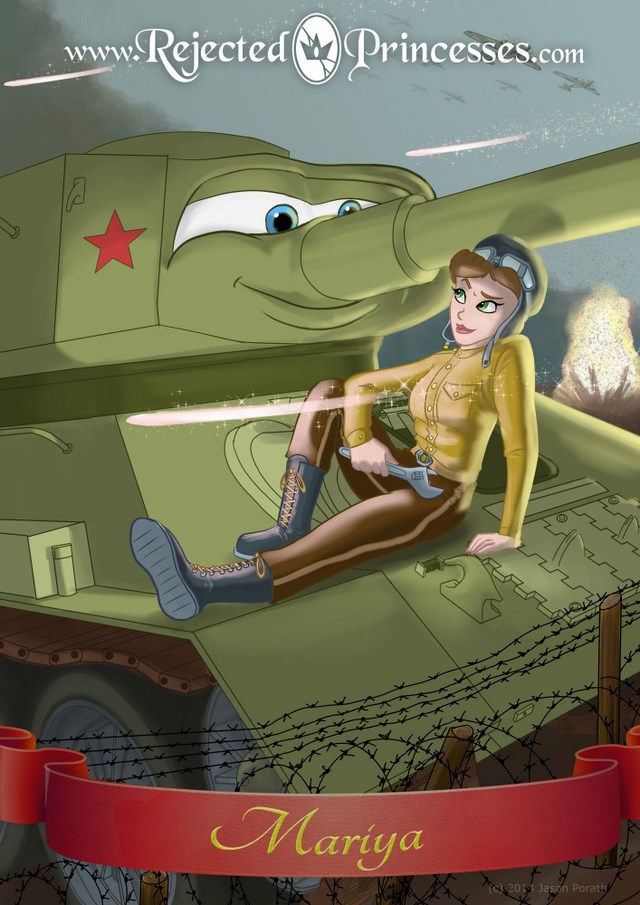
Here’s one of the most badass Rejected Princesses of all: Sergeant Mariya Oktyabrskaya, the first female tanker to ever win the Hero of the Soviet Union award, and her tank, Fighting Girlfriend. During World War 2, her army officer husband Ilya was killed in action. In response, Mariya sold literally all of their belongings in order to buy a tank. She then wrote Stalin the following letter: “My husband was killed in action defending the motherland. I want revenge on the fascist dogs for his death and for the death of Soviet people tortured by the fascist barbarians. For this purpose I’ve deposited all my personal savings – 50,000 rubles – to the National Bank in order to build a tank. I kindly ask to name the tank ‘Fighting Girlfriend’ and to send me to the frontline as a driver of said tank.” Stalin wrote back pretty quickly and said yes. Initially, the army was skeptical of her ability to handle a tank. However, she quickly proved in training that she could drive, shoot, and throw grenades with the best of them — skills she’d picked up from her late husband, with whom she’d presumably had some interesting dates. On her first outing in the tank, she outmaneuvered the German soldiers, killing around thirty of them and taking out an anti-tank gun. When they shelled her tank, immobilizing Fighting Girlfriend, she got out — in the middle of a firefight — and repaired the damn thing. She then got back in and proceeded to kill more Germans. During all this, she wrote a letter to her sister describing her time in the war. She told her “I’ve had my baptism by fire. I beat the bastards. Sometimes I’m so angry I can’t even breathe.” In the end, she was taken out by a mortar round when she got out of her tank in the middle of yet another firefight to fix Fighting Girlfriend. She was awarded the highest honor in the Soviet Military and is buried with highest honors in one of the nation’s most sacred cemeteries. Art notes: * That’s roughly what her outfit would have looked like, depending on the time of year. * The model of tank depicted is a T34 tank, the actual one that Fighting Girlfriend was. * The Fighting Girlfriend logo was on the side of the turret, just out of the cropping of this picture, so it didn’t make the cut. I didn’t want to be inaccurate and just put it on the turret. * Mariya is actually sitting in front of the small gunner’s turret, so her seat wouldn’t be very comfortable, but it makes for a better composition. * The German soldiers used many different color tracer rounds, but red was among them. * The planes in the background are PE-8 Petlyakov Soviet bombers.
Mai Bhago
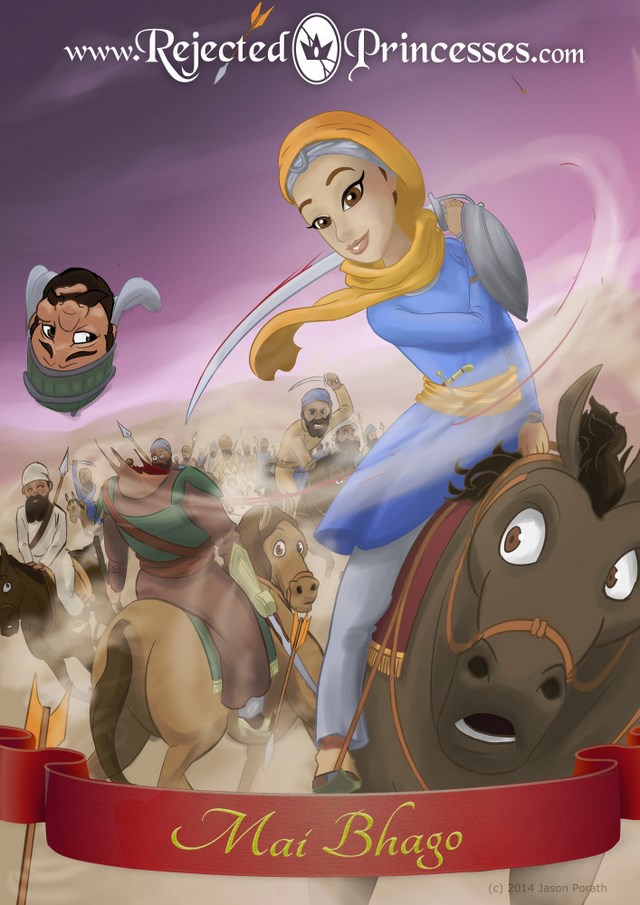
Introducing the eleventh Rejected Princess: Mai Bhago, 18th century Sikh warrior-saint and only survivor of the Battle of Khidrana. A quick bit of background, since it may be that you, like me, do not know a ton about Sikhs. You probably know that they’re the guys who wear turbans, don’t shave, and consistently get mistaken for Muslim — usually by ignorant morons who are trying to start something. Frustrating as that is, douchebags attacking them for virtually no reason is something that Sikhs have had to live with for the majority of the religion’s existence. Exhibit A: the Mughal Empire. The Mughals were badasses. Their founder, Babar, had quite the lineage to begin with: descendant of Tamerlane (an Uzbeki warlord known for constructing pyramids out of his enemies’ skulls) on his father’s side and grandson of Genghis Khan on his mother’s. The Mughals continued and refined this legacy. On the one hand they did so militaristically, riding elephants into battle, redefining warfare, and expanding the empire until it encompassed all of present-day India and beyond. On the other hand, they also advanced literature, culture, and the arts tremendously. They built the Taj Mahal, giant libraries, and had a tremendously multicultural empire. For more info on that, check out Akbar the Great, who — having brought together a huge number of disparate peoples in a surprisingly peaceful, literary, and secular empire, especially for the time — definitely earned the moniker. Unfortunately, by the time this story begins, the Mughals were being ruled by Aurangzeb, who was neither peaceful nor understanding. He was particularly aggressive towards the Sikhs, partly because of religious reasons, partly because the Sikh weren’t down with the caste system. In fact, the Sikhs were egalitarian in general, with women considered equals to men. Which brings us to Mai Bhago. Sorry for the long intro, I just want you to know what she was up against. Mai lived in a peaceful rural town with her parents. She spent a lot of time with her dad, who, in their daddy-daughter hangouts, taught her what any good father should: how to be a devoted Sikh, how to ride a horse, and how to kill anyone who starts shit with you. All of these came in handy just a few years later, when the leader of the Sikh, Guru Gobind Singh, founded the Khalsa — the warrior-saints. You see, the previous Guru before Gobind Singh — and there were only ever ten of these guys to ever live, with Gobind being number ten — was executed by Aurangzeb when Gobind was nine years old. Rather than capitulating to Aurangzeb and living a quiet life, Gobind ordered his followers to eschew the caste system, forsake their family names, be baptized as warrior-saints, and kick ass for the lord. Mai Bhago was one of the first to get down on that. The following years were very difficult on the Sikhs, with the Mughals waging nonstop warfare on the Guru. As tough as it was on him, it was arguably tougher on his warriors, holed up in fortress after fortress, eventually subsisting on nothing but nuts and leaves. After months of this, with heavy hearts, forty of them forsook the religion and left the Khalsa, in order to return to their normal lives. Mai Bhago was having none of that shit. Upon hearing about the forty deserters, she rode to every city around and got all of the women to refuse any hospitality to them. She even rounded up a group of women to take up arms in the deserters’ place — telling the forty to either stay behind and look after the children or sack up and fight. Suitably ashamed by this, the forty deserters had a change of heart and decided to rejoin Gobind Singh’s cause. Just in time, too — because as the forty (plus Mai) were riding back to the Guru, the Mughals were making another assault on his stronghold. The size of the army is difficult to determine from historical records, with the only source I can find claiming the Mughals had ten thousand men, which seems a bit ridiculous. In any event, it is agreed that the Sikhs were massively outnumbered. On December 29, 1705, the forty-one Sikhs rushed in to cut off the Mughals anyway. They did several clever things in and leading up to the battle: 1) Positioned themselves in front of the Khirdana reservoir, the only source of water for miles around, and defended it viciously. 2) Laid sheets across bushes everywhere, giving the appearance of tents — and then hid in nearby bushes, ambushing the Mughals when they started attacking the empty “tents”. 3) Kicked up a colossal amount of dust, attracting the attention of the retreating Guru — who proceeded to unleash an unholy hell of arrows from a nearby hill upon the Mughals. Eventually the Mughals, battered and thirsty, withdrew. All forty of the deserters died in that battle, as did a large number of Mughal soldiers. Mai Bhago was the only Sikh survivor. From there, she became bodyguard to Guru Gobind Singh, last living guru in Sikh history. She outlived the old man and later died of old age herself. The Mughal Empire under Aurangzeb’s leadership began a slow decline and died out a bit over a century later. The Sikh religion continues strong to this day. Her spear and gun can still be found in Sikh museums, and her house has been converted into a temple. And lastly: although best known by the name Mai Bhago, technically her name, after converting to Khalsa, was Mai Bhag Kaur — Kaur being a surname all female Khalsa take, meaning, literally, “princess.” As an art note: she is depicted here not just wearing the traditional Khalsa clothing, but that of the Nihang, an elite warrior Khalsa sect. This outfit includes a variety of bladed weapons (the Guru was known to have five weapons on him at all times), electric blue robes, steel-wrapped turbans, and steel bangles about the wrist. I am unsure if she was technically Nihang, but for damn sure she had their spirit. And yes, she is decapitating that guy. Follow the trail of dust to see the arc of her sword. She has her sword and shield on the same arm, up around her shoulder. Realistically, I should have put the shield on her other arm, but hindsight is 20/20. Lastly: the Mughal being beheaded has period-accurate clothing, although his helmet is one of an infantryman and his outfit is that of a cavalryman. I wanted to be able to see his face.
Corn Maiden
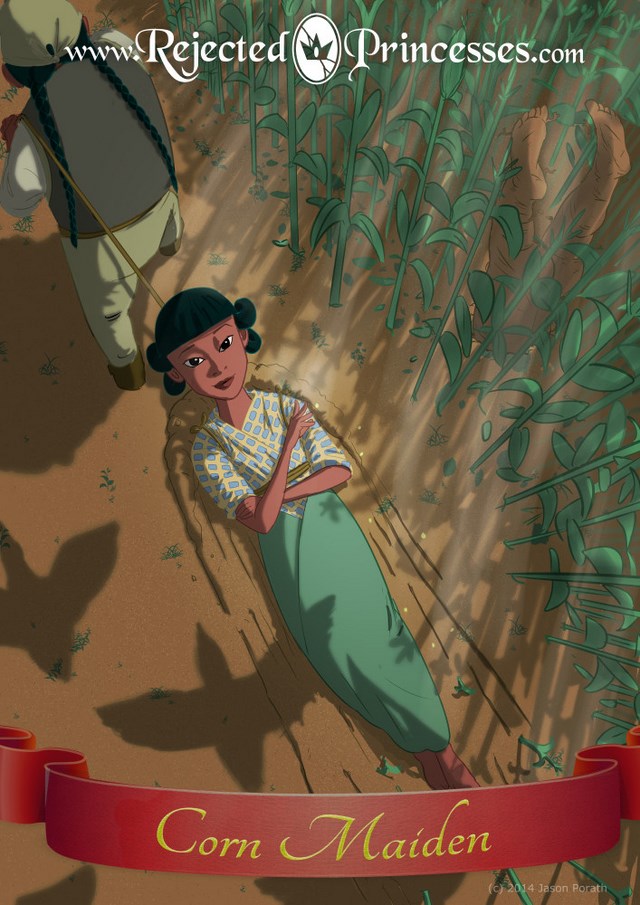
Ladies and gentlemen, I present to you undoubtedly one of the strangest Rejected Princesses: Corn Maiden, mythological Native American figure. Corn Maiden figures into a vast number of tribe mythologies, all of which are slightly different from one another. This much is generally agreed upon across most of the stories: * Corn Maiden was a pretty neat lady who settled down with the tribe in question, a long time ago. * Somehow, whenever she was around, the corn storehouses would overflow! Corn for everyone! It was pretty great! * But, she warned, never try and check out why or how that’s happening. * Eventually someone did, only to find Corn Maiden secretly rubbing corn off her skin in the most delicious case of leprosy ever recorded. * In some versions, it’s hinted that she was actually pooping it out into bucket after bucket, bag after bag, like a chunky firehose. From there, one of two things happened: 1) The tribe chased Corn Maiden out of town, subsequently ran out of corn, realized their terrible mistake, and attempted to find her/make amends, or: 2) The tribe decided to kill her for witchcraft, at which point Corn Maiden was like, “Okay cool, but after you kill me, drag my gruesomely-murdered corpse around the field, and corn will pop up wherever you go. Taking one for the team here, guys!” I probably don’t need to tell you which one is my favorite. The variations across this legend are innumerable. In the Arapaho tradition, to get rid of her, they tied her up and tossed her in the river. In the Zuni telling, instead of the tribe as a whole driving her off, she was frightened off by the erotic gyrations of the male dancers — only to be later found, after the head rain priest climbed a giant tree to look for them, hiding underneath the shadow of a duck’s wing, deep in the ocean. Undoubtedly the absolute zaniest Corn Maiden tale is the Tepecano version. Due to a lot of exposure to European cultures, their legend got warped into a sort of hyperactive medieval fanfiction that was easily twice as long as any other tribe’s version. Try and follow me here. This guy, let’s call him Joe, is lazy and stupid. He finds Corn Maiden in a clearing and is like, “Hey God!” — yes, we’re talking Christian Jesus here — “can I marry her?” and God is like, “Sure why not.” So he marries Corn Maiden, despite never having seen her face or apparently talked to her. On the way to their house, a personalized cloud forms around Corn Maiden’s head, obscuring her features. She then retires to a private room the first night in his family house, and in the morning, it’s full of corn. How mysterious! From there, it is a comedy of errors how poorly things go for poor Corn Maiden: * Joe’s mom makes some corn tortillas and burns the shit out of them, which in turn burns the shit out of Corn Maiden’s clothes and skin. * Joe starts cheating on Corn Maiden with a turtle, whom I cannot tell is actually human or a literal turtle. For hilarity’s sake, I am imagining a literal turtle. * The turtle makes some corncakes, burns the shit out of them, which, again, burns the shit out of Corn Maiden. * Joe then cheats on Corn Maiden with a raven. Again, picturing a grown man screwing a literal bird here. * The raven then steals some grain, which pisses off Corn Maiden some more. * Corn Maiden, sick of Joe’s shit, runs off. * Joe goes to God on bent knee, promises he’ll be better, and God is like, “Okay, I believe you. Hey Corn Maiden, get back with Joe.” And she does. I mean, what you gonna do? * At this point, Joe is pretty curious as to what Corn Maiden actually looks like. So, despite being told — by God — in no uncertain terms NOT to look at her face, Joe waits until she’s asleep and lights a lamp. She is, of course, beautiful. * Joe then drops the lamp on her face, again burning the shit out of her. * Corn Maiden gets the heck out of his house and runs off before someone else sets her on fire. From there, it gets EVEN WEIRDER. Joe goes searching all over the world for Corn Maiden, but nobody has seen her, not even God. Eventually Joe finds her in the magical city of Merlin, where the wind does not blow. He then has to bust her out of Merlin prison, fighting off the palace guards in the process, alongside his buddy, Wind — who is an anthropomorphic embodiment of the concept of wind. Told you it was like medieval fanfic. Immediately after exiting the citadel of Merlin, Corn Maiden turns into a bunch of corn in a field, and says, “Hey Joe! Look after me for one month, I’ll be back, I just have to do this one thing.” Joe makes it a whole fifteen days before getting married to some other girl. Who, presumably, was yet another form of wildlife. At the wedding, Corn Maiden shows up, drags Joe up in front of God, and is like, “THIS GUY IS A TOTAL DICKBAG.” God finally agrees and turns Joe into a weird vegetable-man-thing, with his head planted in the soil and his feet dangling in the air. Art notes: * Her dress is designed to look like corn, with the skirt being the eaves and the shirt being corn-patterned. In many versions, she was responsible for blue corn more than other colors, so I made the kernels blue. * Joe is visible on screen right. * Ducks are flying overhead, as she was found underneath their wings in the Zuni version.
Lolita

Lolita, light of my life, fire of my loins. My sin, my soul. Lo-lee-ta: the first Rejected Princess ever illlustrated, and poster child for childhood sexual abuse. Vladimir Nabokov’s book and its titular character have entered common lexicon at this point, but as a recap: the main character, Humbert Humbert (a man so nice they named him twice), is rooming at a place in New England, where he meets 12-year-old Dolores — whom he calls Lolita. He gets obsessed with her, going so far as to marry her mother so he can be close to her. When the mom dies, Humbert starts shacking up with Lolita, and the two end up going on an incredibly long and epically uncomfortable-to-read-about road trip. Eventually she runs away from him, hooking up with a shady playwright, who later tries getting her into the adult industry. Years later, Lolita, now abandoned, destitute, and pregnant, seeks out Humbert for help. Humbert proceeds to kill the playwright, get thrown into jail, and write the book you’ve been reading, as his memoirs. Despite the book being named after her and her being the main character, even at the end, we don’t know much about Lolita — because the narrator, Humbert, is so incredibly unreliable. He comes across as a charming man with creepy predilections, but once you take a step back, you realize this is all coming from the viewpoint of a pedophile who is in jail for murder, and perhaps her actions, as described, should, you know, not be taken at face value. Since it is the sort of book that requires a lot of between-the-lines interpretation, there is more written about Lolita than I could possibly hope to cover. Some of the wackier readings of the book I’ve come across: – It’s a metaphor for Russian imperialism and tyrrany from the viewpoint of the tyrant. – It’s a metaphor for the decay of American culture and morals. – It’s a metaphor for the exploitative nature of capitalism. – It’s a metaphor for the women’s liberation movement gone mad (no, seriously, I found a jackass on a webforum arguing this, despite it having been published easily ten years before the women’s lib movement — I can only presume he read a different book) Art notes: she has gray eyes, just as described in the book. The motel number, 342, is the actual room number were she and Humbert consummated their relationship. Everything in the scene, save Lolita herself, is a purposely sickly, desaturated color, making her stand out all the more. And yes, the placement of her flipped-up sandal in front of Humbert is intentional.
Penta of the Chopped-off Hands

Most everyone knows that the commonly-reproduced versions of fairy tales are a far cry from their horrific origins. Cinderella’s stepsisters cut off their heels to fit in their shoes, Rumplestiltzkin tore himself in half when he was found out, the little mermaid commits suicide. But some are just too messed up to even approach re-telling, and such is the case of the first fairytale Rejected Princess: Penta of the Chopped-off Hands. Penta grew up as royalty, sister to the king. When the king’s wife died, he spent some time looking for a new wife, but could not find anyone equally beautiful — except for Penta. So he decided, you know what, screw it, I’m the king, and I’m gonna marry my own sister. Penta set about trying to dissuade the king from this course of action. She asked what attracted him to her so much, and he answered, “your hands.” So she ordered her servant to chop off her hands and bring them to her brother, the king, on a platter. The king was not amused. In return, he stuffed her in a trunk and tossed it in the ocean. She floated around for a while, somehow not dying of blood loss, until she was found by a kindly fisherman. But the fisherman’s wife, Nuccia, was having none of it, and promptly tossed Penta back in the ocean. This time, Penta washed up on the shore of the Green Earth king’s lands, where she quickly became the queen’s servant — somehow expertly tending the queen’s hair with her feet. The queen died soon thereafter (seemingly unrelated to Penta foot-wielding scissors near her face), and said, “hey Green Earth King, you should marry Penta, she’s pretty cool.” So he did, thus fulfilling Penta’s bizarrely recurrent destiny as a backup wife. Soon thereafter, the Green Earth King went sailing, and while he was out, Penta had a kid, presumably his. His servants sent word to him on a boat, but somehow it was intercepted by the fisherman’s wife, Nuccia. For reasons unknown, she changed the note to say that Penta had given birth to a dog. The king was apparently cool with this, and wrote a letter back saying, “hey, shit happens. Tell her it’s cool.” And again, Nuccia changed the letter, this time to say, “a dog?! Jesus! You know what, you should just kill Penta. Kill her! I ain’t havin’ no dog-baby!” The Green Earth King’s counselors were more than a bit suspicious of the letter, but, wanting to obey, banished Penta (and child) instead of straight-out killing her. She wandered off, and ended up hanging out with a sorceror, who was impressed by how shitty her life story was. The sorceror decided to have a pity party competition, and invited people all the world around to come to his castle and tell stories about who has the crappiest life. Well, Penta’s brother, still on his woe-is-me kick, shows up and tells his story. The Green Earth King shows up and tells about how he lost his one true love due to some interfering shrew of a fisherman’s wife (whom, it should be mentioned, the king had by this time ordered to be covered in wax and set on fire). The sorceror realized who the two were, and reunited them with Penta. The story ends with the sorceror magically regrowing her hands, and leaves off the part where she no doubt started strangling her brother in full view of everyone. Now, surprisingly, this sort of fairytale — women with chopped-off hands — is so common that it actually has its own classification (Aarne-Thompson type 706B). Other variants include: – Her father trying to marry her instead of her brother (gross) – Her brother chopping off the girl’s hands because he thought she’d murdered his baby (when in reality the brother’s insanely jealous wife had done so – after breaking all their furniture, killing his horse, and blaming it all on the now-handless sister) – Her stepmother chopping off her hands and gouging out her eyes (also in this one, she was born alongside a talking snake) …it goes on. I could seriously do an entire calendar of amputee fairytale girls. Art notes: * Because it’s an Italian fairytale, the dog in the boat is an Italian greyhound. * The ship is a Polacca, a type of merchant vessel popular with the Venetians in the 1700s (when this fairytale was recorded). * The chest is based off an actual 18th century Italian chest I found online, not that you can really tell — it was a pretty ordinary-looking chest.
Beloved
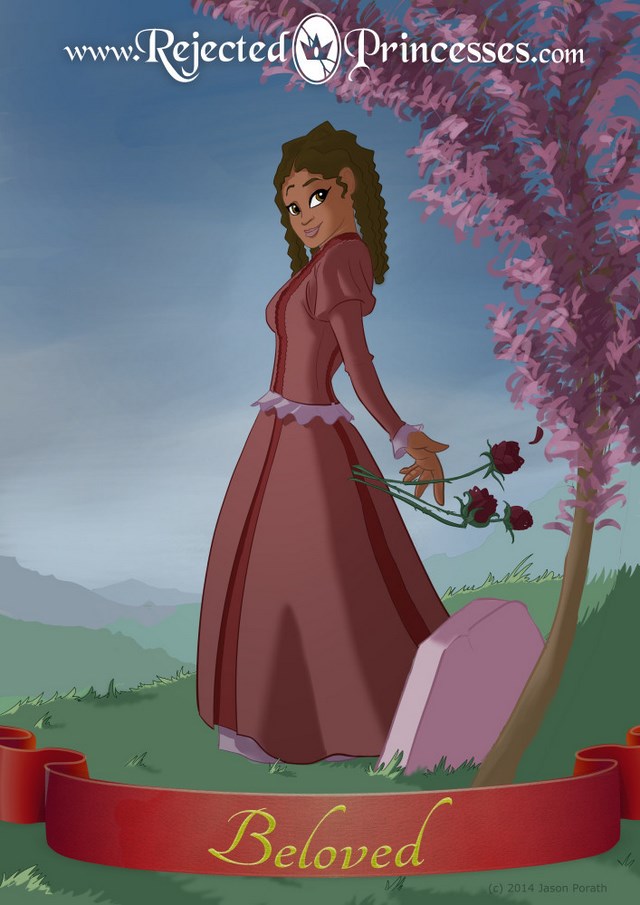
If you aren’t American, there’s a fair likelihood you’ve never heard of the next Rejected Princess: Beloved, from Toni Morrison’s novel of the same name. Beloved is the story of Sethe, a freed slave in post-Civil War era Kentucky. In order to keep her two-year-old daughter from slavers, she ends up slitting the baby’s throat, killing her. Fast forward about a decade, and Sethe is living a fairly settled and peaceful life, when she stumbles upon a beautiful young woman, who appears confused, homeless, and and halfway drowned. This is Beloved. Beloved moves in with Sethe, and the other various characters in the story start noting how similar she is to Sethe’s dead daughter: she’s the same age that the dead daughter would have been had she lived; she has a scar across her throat; her breath smells like milk; her temper is mercurial, like a child’s; even her name, Beloved, is what was written on the two-year-old’s gravestone. Sethe begins to see it, basically losing everyone in her life in capitulating to the increasingly erratic whims of her spectral houseguest. Eventually Sethe’s other daughter, Denver, arrives with a posse to exorcise Beloved from the house. A fracas ensues (Sethe stabs a white man that Denver brought along — it’s complicated), and Beloved disappears in the process. The book is about a lot of things, but primarily the effects of slavery on one’s mind — Sethe is trying to make a clean start, but coming up with a new personality as an adult, while keeping her past sealed away from memory, proves too difficult for her to manage. As a result, she’s literally haunted by her past. You should read it. It’s a great book, even if I did just spoil all of it for you. Art notes: * The dress is based off of one that she wears in the movie adaptation. It may not be super period-appropriate, but I liked how it came out, so I kept it. * Beloved has a tiny, hard-to-see scar on her neck. It’s there, I swear! * She is tossing rotten roses on her own gravestone (which was pink). Rotten roses are a motif throughout the book. * The mountains in the background are based off a picture of the Black Mountain area in eastern Kentucky. * The tree is a chokecherry tree, also a motif from the book: the scars on Sethe’s back from being whipped are said to make the pattern of a chokecherry tree.
Sita
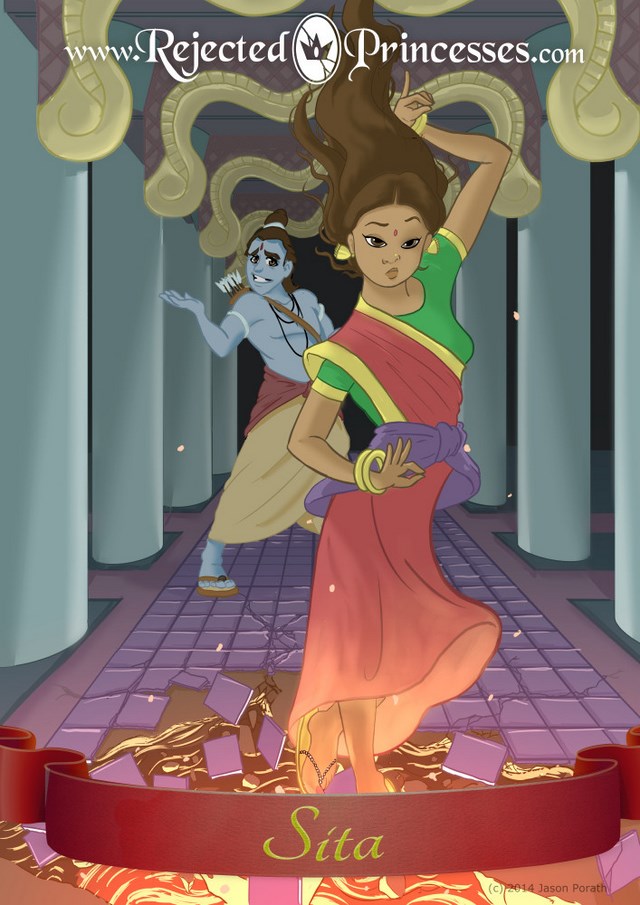
Next in the line of rejected princesses: Sita, from the Ramayana. For those unfamiliar with the Ramayana, here’s a cliffs notes version: for 90% of the book, it’s basically Mario/Princess/Bowser by way of Tarantino. Bad guy (Ravana) kidnaps princess (Sita), good guy (Rama) goes on bloody rampage for years in order to get her back. Kills Ravana, gets back the princess, yay for everyone. But then there’s that last 10% of the book. About 5 pages after they get back, cut to Rama talking to his advisors. “Advisors,” he says, “what are the people saying about me?” “Oh man, Rama, they totally love you. Way to rock it with killing that demon guy.” “Wait, EVERYONE loves me? No way. There’s gotta be SOMEONE who’s not on board.” “Well, I mean, there’s some knucklehead…” “Well, what’s the knucklehead saying?” “He’s saying that Sita totally hooked up with the bad guy, but, I mean, he’s a knucklehead.” “Wait, what? People are saying that? Oh shit. Hey Sita, get in here! Hey baby, I can’t be seen with you. People are saying you’re a slut. Now, I know you’ve passed like, my hundred other purity tests, but still. GTFO and go live in the woods for the rest of your life.” She then goes into exile in the forest – pregnant with their kids. Cut to many years later, Rama’s having a festival, and some awesome guys show up. They wow everyone, and Rama’s like, “oh hey, who are YOU guys? You’re awesome!” They’re like, “SURPRISE! We’re your kids! Also, Sita’s alive and in the forest.” Rama: “Oh shit! Yeah, that whole thing with Sita was totally my bad. Hey, can we get her in here? I got some smoothing over to do.” Sita shows up, and is like, “no, guys, it’s cool! Hey, I’ll settle this once and for all. Everyone listening? Okay, so if I did NOT hook up with the demon guy, may the earth swallow me whole.” Bam, lava, the end. Art notes: * That’s Rama in the back, doing his best “what I’d do, baby?” face. * Sita is doing a traditional Bollywood-style pose, except her upper hand is flicking Rama off.
Fredegund
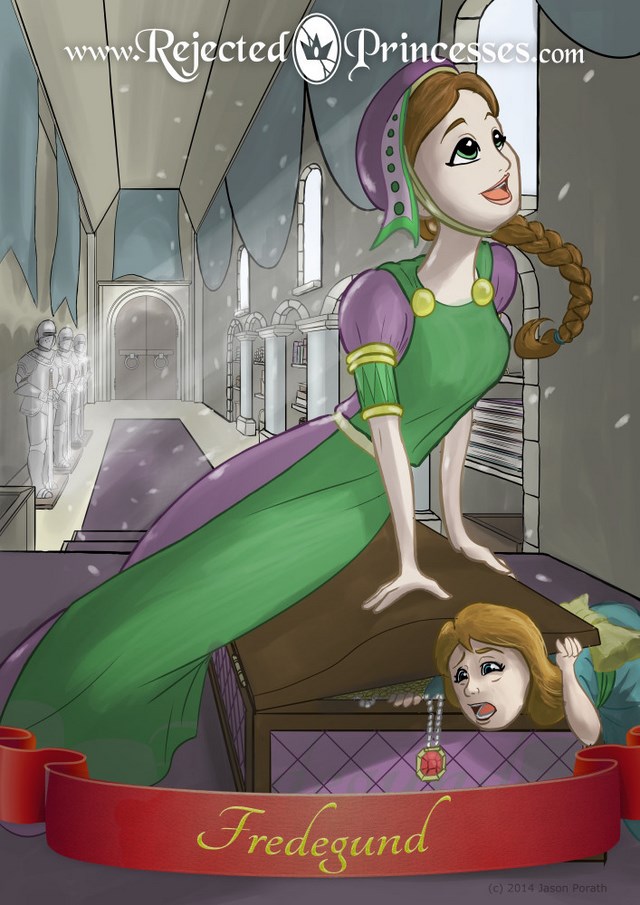
Here’s another one for you all. Fredegund was a 6th-century Merovingian queen consort with a penchant for strangling people. While she was best known in her day for having the old queen (a 60-something lady) tortured on the rack before being torn apart by horses, another one of her feats stood out more to me. You see, she had a daughter, Rigunth, who was looking forward to being queen consort one day. Exasperated by her daughter’s whining, Fredegund told her to look inside the king’s treasure chest and pick out some jewelry for herself, to tide her over. When Rigunth poked her head in the treasure chest, Fredegund slammed it shut on her neck. She would have killed the girl, had servants not stopped her. (note of interest: this was originally done and posted on Mother’s Day, haha!)
Hatshepsut

This prncess definitely falls under “too awesome”: Hatshepsut, arguably the greatest pharaoh in history. Forget Cleopatra, King Tut, or Nefertiti — Hatshepsut was the jam. You’d be forgiven for not knowing about her, though. Thanks to a sustained campaign by her successors to erase all traces of her reign, it was not until fairly recently that she came back to historical prominence. She was re-discovered due to the fact that her time in power saw such an incredible proliferation of architecture, statues, and art that it proved impossible to scrub mention of her from *everything*. So much of her work has survived to present day that almost every major museum in the world has at least one piece from her. The New York MoMa has an entire room devoted to her. All this, despite the fact that she ruled for less than twenty-two years, fifteen hundred years before the birth of Jesus. In fact, speaking of Jesus — you know the myrrh that the wise men brought to his birth? Almost certainly due to Hatshepsut importing it 1500 years earlier, in the first recorded attempt to transplant foreign trees. Moreover, she did her own PR. In order to solidify her claim to the throne, she spread word that her parents were told by the gods that she was to be pharaoh. The official story was that, at the gods’ behest, her mother gave birth to her in a LION’S DEN. To quiet the gossip at court, she began her rule wearing men’s clothing, including the pharaoh’s false beard. Once they stopped flapping their gums, she went back to wearing whatever the hell she wanted.
Make sure you follow Jason’s site to see more Rejected Princesses every Wednesday
